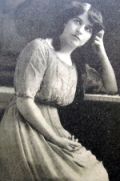
Photo courtesy of Fryer Library
from the Theatre Magazine (October 1916)
ADDITIONAL SONGS ATTRIBUTED TO ELLA AIRLIE: Publication details unknown or not established.
'Go Away Mr Crocodile' (ca. 1915) [cited Theatre Magazine March 1915, p.35]
'If Everyone Thought as Mother' (ca. 1915) [cited Theatre Magazine March 1915, p.35]
'We're Not Downhearted Yet' (ca. 1915) [cited Theatre Magazine March 1915, p.35]
ENGAGEMENTS CHRONOLOGY : An asterix (*) beside a date indicates that it is either approximate or has yet to be established).
1910 : 29 January - * Collingwood Town Hall, Melbourne (first appearance).
NB: Airlie was engaged by the Taits in Melbourne for much of 1910 and 1911.
1915 : 28 August - * Empire Theatre, Brisbane / Queensland regional tour; ca. September-October (see Olympia Theatre, Charters Towers; ca. 2 October).
1916 : ca. February*; Melrose Theatre, Perth / 22-31 December; Grand Opera House, Sydney [The Bunyip].
1917 : 1 January - 2 March; Grand Opera House, Sydney [The Bunyip].
1919 : ca. September *; Bijou Theatre, Melbourne / ca. October *; Adelaide / 29 November - *; Empire Theatre, Brisbane.
PHOTOGRAPHS:
The following list comprises bibliographic details of published and unpublished photographs, caricatures, and drawings of Ella Airlie.
National Library of Australia: Music collection. Portrait photographs of Airlie are included on the covers of a number of published scores from The Bunyip pantomime. Some scores can be accessed online.
State Library of Queensland: Holds several sheet music publications from The Bunyip, which also include a portrait of Airlie.
Theatre Magazine: October 1916, p.19.
West, John. Theatre in Australia, p.129. [From the cover of 'The Bunyip' sheet music]
Williams, Margaret. Australia on the Popular Stage, p.84. [From an advertisement for The Bunyip.]
This entry has been sourced from research undertaken by Dr Clay Djubal into Australian-written popular music theatre (ca. 1850-1930). See also the Australian Variety Theatre Archive